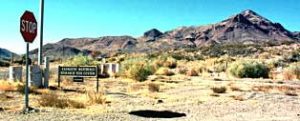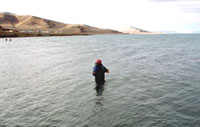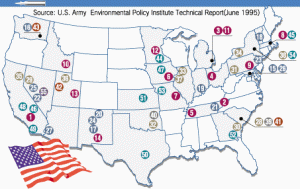Discounted Casualties:The Human Cost of Depleted Uranium, Part 3 Facilities related to DU munitions in USSpecial Reports:
May 14, 2000
Contamination from test firing ranges
Concealed truths
Facilities related to radioactive depleted uranium weapons are scattered over virtually the entire United States. The total number of facilities for R&D, manufacture, test firing, storage, and disposal of DU, including those that have been shut down due to radioactive contamination, is upwards of 50. They are far smaller in size and number than the nuclear weapons facilities spread across the country, but like the testing ranges and disposal sites for the latter, they end up in sparsely populated areas, where they contaminate the environment and threaten the health of local residents.
The map shows the locations of DU munition facilities on a list compiled by the Army Environmental Policy Institute (AEPI) in 1995. I will report on contamination issues related to these facilities, particularly the firing ranges. [Story and photos by Akira Tashiro]
What are the health effects?Persistent fears among residents
The main purpose of DU shells is to destroy tanks made of heavy metals. Test firing of DU shells from tanks requires a large firing range; aerial bombing practice from airplanes requires huge desert bases.
Changing perceptions of the government
The Nelice Air Force Base appears to surround the Nevada Nuclear Testing Site. It is the only DU munition firing site in current use by the Air Force. The base covers 1.25 million hectares (about 4,830 sq. miles). The Nuclear Regulatory Commission (NRC) permits DU rounds to be used on the southeast, or the Las Vegas side, of the base. Here, 7,900 rounds of 30mm shells are tested each year.
Unfortunately, the permissible area happens to lie entirely within a national desert wildlife preserve. DU rounds have been test-fired here since the early 1970s, because radioactivity and heavy metal pollution were not considered serious problems until the mid 1980s. However, a US Congress decision required the Air Force to find 44,500 hectares (about 170 sq. miles) for a wildlife preserve in another part of the state to compensate for the land it contaminated in this area.
Grace Potorti (45) =pictured=, executive director of the NGO Rural Alliance for Military Accountability based in Reno, Nevada, explains the change in attitude of the state residents and state government as follows.
"Nevada cooperated with atmospheric nuclear tests at the Nevada Nuclear Testing Site since the beginning of the 1950s. Until the mid-1980s, it welcomed every expansion of military presence. Then things changed. Though the military presence was doing wonders for the economy, the people and the state government began to realize that the damage to the eco-system and the health of the residents from the use of DU and other munitions surpassed the benefits.
1.5 million unexploded shells
Through the Internet, the Alliance exchanges information with grassroots groups located near military bases all around the country. According to Potorti, the great majority of DU firing ranges are located in sparsely populated areas and are embroiled in controversy regarding radioactive contamination.
One of these is the Army's Jefferson Proving Ground (JPG) in southeast Indiana. To demonstrate the power and accuracy of DU rounds, test firings were repeatedly carried out over 22,300 hectares (about 85 sq. miles) between the mid-80s to 1994. The legacy is about 70 tons of DU, shell fragments, and contaminated storage buildings.
Since 1941, JPG has been test-firing various other kinds of weaponry as well-about 1.5 million unexploded rounds were simply abandoned there.
costsTremendous clean-up
The Department of Defense has decided to close JPG, but closing and returning the base to the state of Indiana requires decontamination. An environmental report on JPG by researchers at the Los Alamos National Laboratory (New Mexico) in 1996 estimated that a total of $7.8 billion would be needed to clean up the DU alone.
Faced with such a mind-boggling figure, the cleanup has bogged down. Until it takes place, wild deer and other animals living in the vicinity of the radiation-contaminated base will absorb depleted uranium through the air and food.
Area residents have long hunted deer for food and pleasure. People who eat that venison will absorb depleted uranium concentrated by the food chain. They can buy safe drinking water, but they cannot escape the dangers of raising cattle, other livestock and crops on contaminated water.
Though the Department of Defense assures the residents that contamination on the base will not affect their health, Potorti says, "People around here are very worried."
Moreover, as seen in communities living near the firing range of the Energetic Materials Research Test Center attached to the New Mexico Institute of Mining and Technology in Socorro, New Mexico, and the Sierra Army Depot in Herlong, California, the historic homes of native American tribes are being contaminated, and health problems are emerging.
Fabrication, Assembly, R & D, Test Firing, Storage and Demilitarization Sites involving DU Ammunition in USA
[Source: US Army Environmental Policy Institute Technical Report (June 1995) ]
Fabrication and Assembly Sites
1 Aerojet Ordnance Company Chino, California
2 Aerojet Ordnance Tennessee Jonesboro, Tennessee
3 Detroit Army Tank Plant Warren, Michigan
4 Lima Army Tank Plant Lima, Ohio
5 Martin Marrietta Energy Systems
Milan Army Ammunition Plant Milan, Tennessee
6 Mason and Hanger at Iowa Army Ammunition Plant Middletown, Iowa
7 National Manufacturing Corporation St. Louis, Missouri
8 Starmet Corporation, formerly known as Nuclear Metals, Inc. Concord, Massachusetts
9 Olin Ordnance Corporation Red Lion, Pennsylvania
10 Specific Manufacturing Capability Facility Idaho National Engineering Laboratory Idaho Falls, Idaho
11 Tank Automotive Command Warren, Michigan
12 Twin Cities Army Ammunition Plant,
Alliant Tech Systems New Brighton, Minnesota
13 White Sands Missile Range Green River, Utah
14 White Sands Missile Range White Sands, New Mexico
R & D and Test Firing Sitesback to map
15 Army Research Laboratory APG, Maryland
16 Battelle Pacific Northwest Labs Richland, Washington
17 Energetic Materials Research and Technology Center, formerly known as the Terminal Effects Research and Analysis(TERA) facility Socorro, New Mexico
18 Ethan Allen Firing Range (General Electric) Burlington, Vermont
19 Jefferson Proving Ground Madison, Indiana
20 Los Alamos National Laboratory Los Alamos, New Mexico
21 Manufacturing Sciences Corp. Oak Ridge, Tennessee
22 Nevada Test Site Mercury, Nevada
23 Picatinny Arsenal Dover, New Jersey
24 Sandia National Laboratories Albuquerque, New Mexico
25 Tonopah Test Range Tonopah, Nevada
26 US Army Combat Systems Test Activity APG, Maryland
27 Yuma Proving Ground Yuma, Arizona
Storage and Storage/Demilitarization Sitesback to map
28 Defense Consolidation Facility Snelling, South Carolina
29 Hawthorne Army Ammunition Plant Hawthorne, Nevada
30 Hunter Army Airfield Savanna, Georgia
31 Letterkenny Army Depot Chambersberg, Pennsylvania
32 McAlester Army Ammunition Plant McAlester, Oklahoma
33 Savanna Army Depot Savanna, Illinois
34 Seneca Army Depot Activity Romulus, New York
35 Sierra Army Depot Herlong, California
36 Tooele Army Depot Tooele, Utah
37 US Army Armament Munitions and Chemical Command Rock Island, Illinois
38 Watervliet Arsenal Albany, New York
Processing Sitesback to map
39 Carolina Metals Barnwell, South Carolina
40 Sequoyah Fuels Corporation Gore, Oklahoma
Waste Disposal Sitesback to map
41 Chem-Nuclear Systems Waste Management Facility Barnwell, South Carolina
42 Envirocare of Utah, Inc. Clive, Utah
43 US Ecology Hanford, Washington
Former DU Use or Storage Sites, and Sites Being Decommissionedback to map
44 Alliant Tech Systems, Inc. Elk river, Minnesota
45 Army Research Laboratory Watertown, Massachusetts
46 Camp Roberts Military Reservation Bradley, California
47 Chamberlain Manufacturing Waterloo, Iowa
48 China Lake Naval Weapons Center Alliant Tech Systems Ridgecrest, California
49 Ford Aerospace and Communications Corp. San Juan Capistrano, California
50 Fort Hood Killeen, Texas
51 Fort Riley Junction City, Kansas
52 Fort Stewart Hinesville, Georgia
53 Lake City Army Ammunition Plant Independence, Missouri
54 National Lead Industries Colonie, New York
Otherback to map
55 Nellis Air Force Firing Range
*Not mentioned in the Army Technical Report, but still in use Nevada
(Originally published on May 14, 2000)











